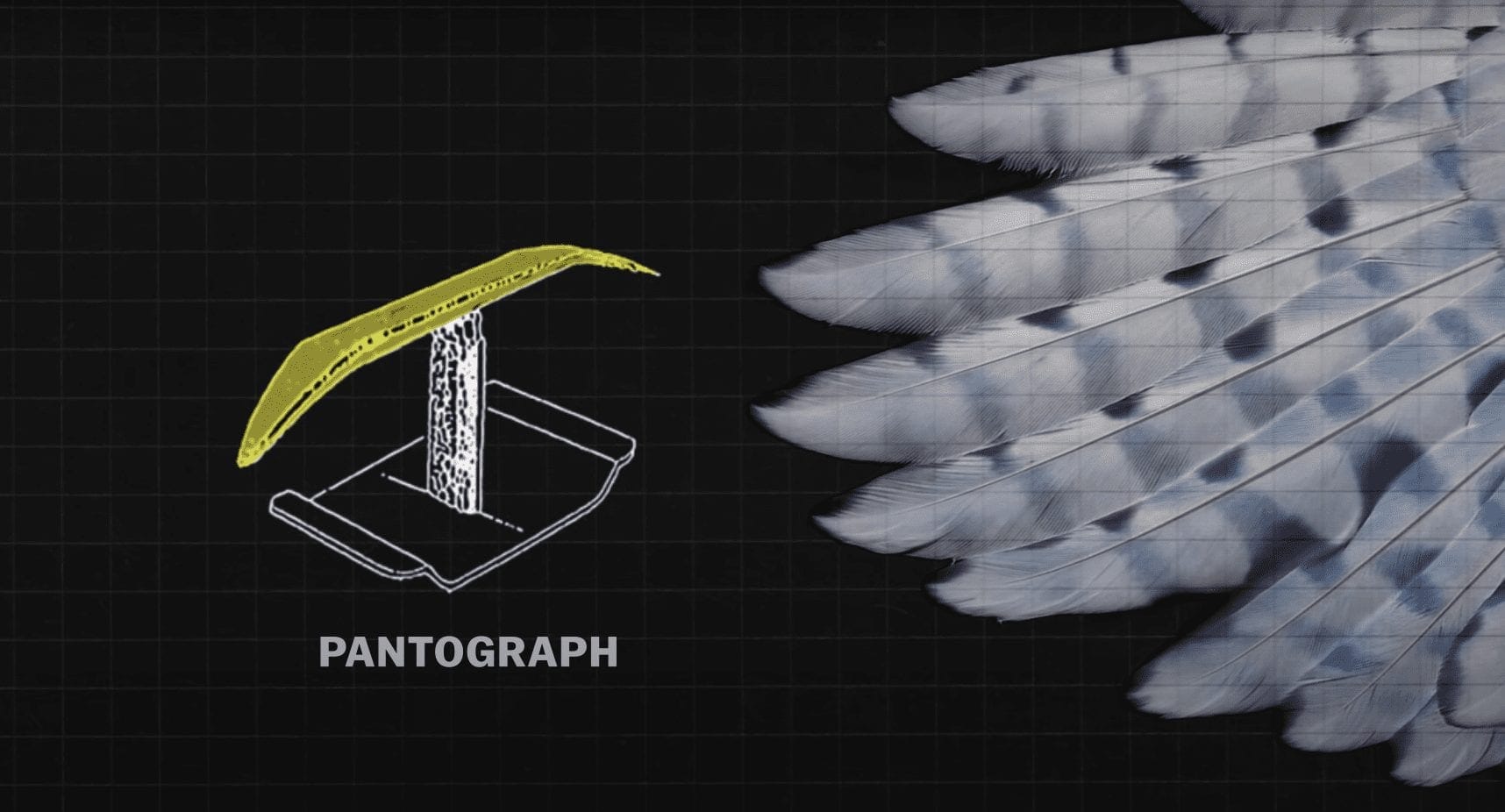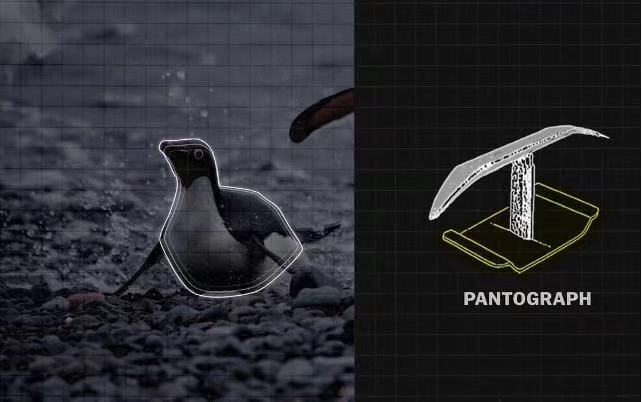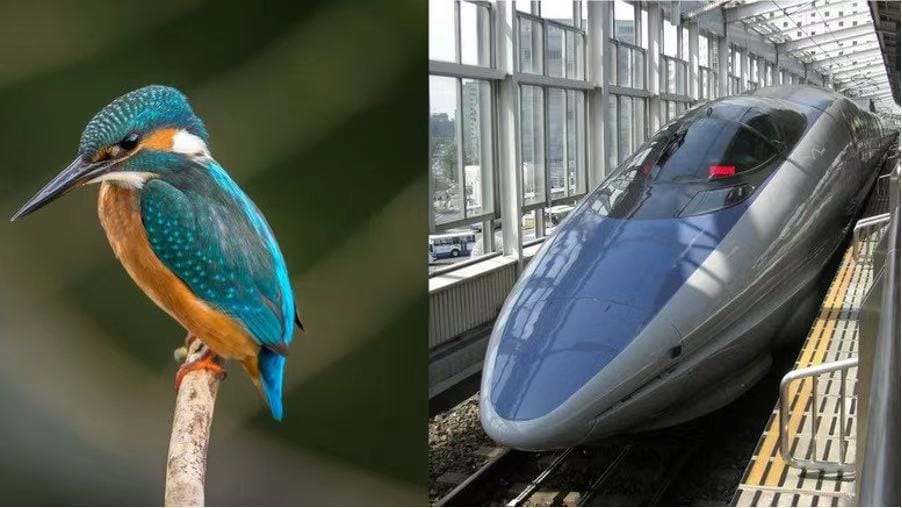Train Design - Natural Inspiration or Copyright Infringement?

From materials and fabrics to buildings, planes and trains, we often see features in man-made designs that have similarities to biological creatures - this is known as biomimicry. Biomimicry is the adaption of biological entities to solve human problems. This technique is used across a range of industries from material and fabric design to transportation and architecture. A common example is the Bird Nest National Stadium in Beijing, which boasts an interlocking steel beam structure reminiscent of a bird’s nest. Moreover, the Eastgate Centre in Zimbabwe is inspired by termite mounds, mimicking its natural ventilation in order to decrease energy requirements for interior cooling.

The Shinkansen
In modern times, biomimicry plays a crucial role in the design of bullet trains, with the most iconic design being the Japanese Shinkansen bullet train. In 1989, the Japanese engineering team faced a problem with the Shinkansen bullet train. It would always emit a loud noise that could be heard from four hundred metres away whenever the train left a tunnel. This was caused by a sudden build-up of air pressure in the tunnel, which was forcefully pushed out ahead of the train, creating a near sonic boom as it left the tunnel. This was a huge problem in residential areas as it caused serious noise pollution.
The Japanese engineering team had to redesign the train with novel features to tackle this issue. As it were, Eiji Nakatsu, the general manager of the technical development, was also a bird watcher. He suggested incorporating avian features to the train to reduce noise pollution. This led to the creation of the 500 series Shinkansen - which had an aerodynamic nose modelled after the beak of a bird - allowing it to move more quietly and efficiently.
One of the main features of the 500 series was the revamped pantograph design. It was a mechanical device that connected the train to the electric wire above. The problem with the previous pantograph was that it created significant aerodynamic noise as the flow of turbulence over the pantograph arms generated high frequency and loud sounds.
Mimicking the owl
The redesign of the pantograph was inspired by owls. Owls are known for their silent travel in the sky to catch its prey. Nakatsu realised that the silent flight of an owl carries was due their specialised feathers. Their feathers contained leading-edge serrations, which are comb-like structures at the front of the wing. This small attribute breaks up the air flow when flying, as the wind will hit the serrated edge of the wing first. This channels the air into smaller streams, breaking turbulence instead of the smooth edge which would have created loud turbulences.

The owl also has a velvety surface on the upper side of its wing. As air travels across the wing, it causes vibration in the feathers. The velvety texture of those wings would absorb and dampen vibrations. It also allows feathers to slide over one another smoothly, reducing frictional noise. Using these insights, engineers replicated the serrated edge on the pantograph arms to break up the air flow and reduce turbulence. The surface of the pantograph was redesigned to have micro- textures like the owl’s velvet feathers, to absorb high-frequency vibrations and further reduce noise caused by turbulence.
Mimicking the penguin
Aside from the pantograph, Eiji Nakatsu also suggested the characteristics of the Adelie penguin. The Adelie penguin is known for its efficient swimming and sliding. The main inspiration the engineering team took from this animal was its streamlined body shape. Their bodies are long and narrow, with tapered ends, creating a torpedo shaped body. This shape allows water resistance to be minimised as the water would flow smoothly over and around their body. The engineers modelled the shaft of the pantograph like the Adelie penguin’s body, which delayed the flow separation as the airflow would now no longer experience a sharp change in shape. As a result, fewer air vortices were formed, which further reduced noise pollution.

Mimicking the Kingfisher
The final redesigned part was the nose of the bullet train. The old Shinkansen had a short and blunt nose. This would compress the air in front of the train as it entered a tunnel at high speed - like a piston - which led to a high-pressured wave burning out as it exited, creating a sort of explosive sound. As previously mentioned, Eiji Nakatsu took inspiration of the attributes of a Kingfisher to fix this. The Kingfisher is a bird known for its silent dive. When it catches its prey in the water, it dives in with barely a splash, thanks the help of its beak.
The engineering team tested this design with a unique experiment. They decided to fire bullet (each with a different shape modelled like train noses) down a pipe to, measure the pressure wave (i.e. sound) each produced. In addition to this, they also dropped the bullets into water to measure the splash size. The bullet shape with the quietest noise and the smallest splash size turned out to be the one shaped like a Kingfisher beak. Why was this?
When an object enters the water, there are two main causes to the size of the splash, which are the drag force and the impact force. To minimise the splash size, these factors need to be minimised. The drag force is the resistance an object experiences as it moves through fluid. The factors of drag force are the fluid density, velocity of the object, the drag coefficient and the cross-sectional area and the drag force could be calculated by this formula below.

The Kingfisher’s sharp narrow beak has a low cross-sectional area; the conical shape of the beak has a low drag coefficient, leading to a low drag force. The Kingfisher’s long beak is also made to reduce the impact force. This is because the force of impact could be worked out by the change in momentum over the time. As the Kingfisher’s beak is long, this increases the time taken, minimising the force of impact. With this, the engineers applied the conical shape to the nose of the bullet train. The cone like nose creates a gradual pressure gradient instead of a sudden one. This reduces the amplitude of the pressure wave as the compression of the air in the tunnel starts slower. The sharp end slices the air as it goes into a tunnel instead of pushing a large volume at once. This also slows the rate of air compression in front of the train resulting in a reduce in noise as the train exits the tunnel.

In the end, the redesign introduced in 1997 was found to be 10% faster, used 15% less electricity, and stayed under the 70-decibel noise limit in residential areas. And the only changes added were inspired from the specialised feather of an owl, the streamlined body of a penguin and the sharp conical beak of a Kingfisher! This shows the significance of understanding the nature around us, as it can make a huge difference in how things would operate.
Conclusion
Studying nature has made human creation and technology more efficient and sustainable and creating a more environmentally friendly and elegant design. From my research, I only focused on the biomimicry of the bird, which solved the major problem of the bullet train. However, I believe that in the future, engineers could discover features on other types of animals that could lead to a more efficient design on a number of things. After all, why come up with new designs, when nature has already provided us with them?